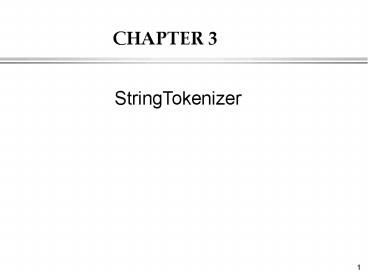Savitch Java Ch. 9 - PowerPoint PPT Presentation
1 / 10
Title:
Savitch Java Ch. 9
Description:
Need to break each line into meaningful units of data called tokens. ... Have the following input data:- Mickey 97 158.50. 9. Example: StringTokenizer ... – PowerPoint PPT presentation
Number of Views:86
Avg rating:3.0/5.0
Title: Savitch Java Ch. 9
1
CHAPTER 3
StringTokenizer
2
StringTokenizer CLASS
- There are BufferedReader methods to read a line
(i.e. a record) and a character, but not just a
single word (i.e. a field). - For example
- William Smith 555-55-5555 76542.56
- Lisa Jackson 444-44-4444 77654.78
- Use method readLine to input data ? entire line
read as a string. - Need to break each line into meaningful units of
data called tokens. - But cannot do this by using BufferedReader.
3
Tokenizing a String
- class StringTokenizer
- Contained in package java.util
- Tokens usually delimited by default whitespace
characters (space, tab, newline) - You can specify other delimiters (the character
or characters that separate words) - Contains methods
- public StringTokenizer(String str, String
delimits) - public int countTokens()
- public boolean hasMoreTokens()
- public String nextToken(String delimits)
- public String nextToken()
4
StringTokenizer class
- To use the StringTokenizer class, create a
StringTokenizer object initialized with the
string to break apart. - A token is a sequence of characters separated by
white space, comma, tab, newline. - nextToken() method
- retrieves the next token from the string
tokenizer - Throws NoSuchElementException if no more tokens
to return. - countTokens() method
- Returns the number of tokens remaining to be
returned by nextToken
5
- hasMoreTokens() method
- Tests if there are more tokens available from
this tokenizers string. - When used with nextToken, it returns true as long
as nextToken has not yet returned all the tokens
in the string, returns false otherwise.
6
Constructor METHODS
- public StringTokenizer(String theString)
- Constructor for a tokenizer using whitespace
characters to find tokens in theString. - public StringTokenizer(String theString, String
delimeters) - Constructor for a tokenizer that will user the
characters in the string delimiters as
separators to find tokens in theString.
7
Tokenizing a String
- Create a StringTokenizer object store the
string in the created object. - StringTokenizer tokenizer
- new StringTokenizer(Hello there!)
- Use the method nextTokenizer with the object
(tokenizer) to retrieve the token from the
string. - str1 tokenizer.nextToken()
- str1 tokenizer.nextToken()
8
StringTokenizerClass Exercise
- 1. BufferedReader keyboard new
- BufferedReader(new InputStreamReader(System.in)
- 2. StringTokenizer tokenizer
- 3. String inputLine, name
- 4. int num
- 5. double decNum
- 6. inputLine keyboard.readLine()
- 7. tokenizer new StringTokenizer(inputLine)
- 8. name tokenizer.nextToken()
- 9. num Integer.parseInt(tokenizer.nextToken())
- 10. decNum Double.parseDouble(tokenizer.nextToke
n()) - Have the following input data- Mickey 97
158.50
9
Example StringTokenizer
- Display the words separated by any of the
following characters space, new line (\n),
period (.) or comma (,).
String inputLine keyboard.readLine() StringTok
enizer wordFinder new StringTokenizer(inputLine
, " \n.,") while(wordFinder.hasMoreTokens())
System.out.println(wordFinder.nextToken())
Question2bor!tooBee
Entering "Question,2b.or !tooBee." gives this
output
10
Text File Input (Example)
- while (record ! null)
- System.out.println("Here goes " record)
- StringTokenizer wordFinder new
StringTokenizer(record,",") - while (wordFinder.hasMoreTokens() )
- System.out.println(wordFinder.nextToken() )
- record inFile.readLine()





























